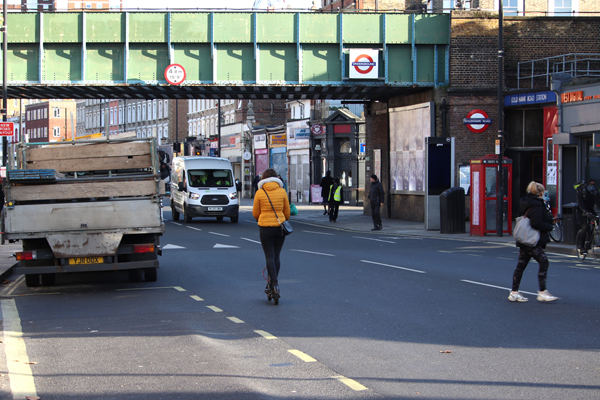Chris Theobald from Guide Dogs looks at the impact of e-scooters on people with sight loss and the wider community.
Last summer the Government fast-tracked and expanded plans for a 12-month trial of e-scooter rental schemes in cities across England. The aim is to assess how they might fit into the community as a new alternative transport method to reduce car and public transport use. Since then, e-scooters haven’t been far from the headlines with reports of dangerous and anti-social use almost since the day they were introduced.
Government trials dictated that e-scooters would be fitted with a 500W electric motor and could go no faster than 15.5mph, with rental e-scooter users being allowed to drive on the road or in bike lanes, but not on the pavement.
Since their introduction e-scooters have become an emerging problem for pedestrians, but for many blind and partially sighted people they are a serious safety issue, especially when misused.
E-scooters are almost silent, which means that people with sight loss have little or no warning they are approaching. Blind and partially sighted people typically rely on hearing to navigate safely, which makes detecting and avoiding e-scooters riding on the pavement almost impossible.
We’ve heard from several people with sight loss who have had encounters with e-scooters. One guide dog owner was hit by an e-scooter carrying two schoolboys last year which knocked her over and into her guide dog. Thankfully the guide dog owner and her guide dog were not seriously injured, but things could have been so much worse.
Guide Dogs is extremely concerned about the way e-scooters are being misused and for the safety of the wider community.

An e-scooter being ridden illegally on Goldhawk Road, West London, December 2020
Government trials have sparked a boom in e-scooter sales, with Halfords reporting a 450% increase in October 2020 on the previous year. But how many people buying e-scooters realise that they are illegal to use on public land, and they could face a potential £300 fine and up to six penalty points on their driving licence?
This explosion in e-scooters has, not surprisingly, seen a corresponding increase in reports of dangerous and anti-social use. Earlier this year a YouGov survey for Guide Dogs found that half of the people who had come across e-scooters saw them driven unsafely.
The same survey also shed a light on the sheer extent of illegal e-scooter use. E-scooters were most commonly found in London, with 63% of those questioned seeing an e-scooter, with one in four seeing one at least once a day – despite there being no legal e-scooter trial in London at the time.
But when we asked police forces what action they were taking, very few said they were doing anything at all. Without enforcement, unsafe behaviour such as e-scooters being driven on the pavements becomes the norm.
Government trials are designed to test how the legalisation of e-scooters might impact wider society, but they are already present in growing numbers on our streets.
The Department for Transport recently reported 11 ‘serious’ incidents during e-scooter trials which required medical treatment. There were 62 further incidents involving ‘slight’ injuries up to March this year. We believe the actual number of people being injured by e-scooters is much higher as many incidents will go unreported and these figures of course do not cover privately owned e-scooters, of which there are hundreds of thousands being used illegally.
The quiet nature of e-scooters makes them almost impossible for people with sight loss to identify. A requirement for electric cars to make a constant sound at speeds of under 20kph is currently being phased in. E-scooters should be required to do the same. E-scooter operators need to test audible warnings for e-scooters and the Government should support research into this, to ensure a consistent approach is taken.
The Government must also support police services to enforce against unsafe use and e-scooter operators need to take responsibility for unsafe parking of rental e-scooters, with clear zones for parking that will not be an obstacle to people with sight loss. As well as consequences for users if they block the pavement.
Major retailers have a role to play too because they are able to sell privately owned e-scooters, many of which do not have to meet the safety requirements set out by the Government for e-scooter trial schemes. It can take just 30 seconds to find e-scooters on sale online with top speeds of up to 50mph – some marketed as ‘great for commuting’. Retailers need to take responsibility to discourage dangerous and illegal use and make clear to their customers that privately owned e-scooters are illegal to use on public roads.
Even a near miss with an e-scooter can rob people with vision impairment of the confidence to go out independently. If e-scooter use continues to grow in the way we’ve seen over the last 12 months, more people with sight loss will be forced to change their route or avoid independent travel altogether.
Legalising e-scooters would have a dramatic and irreversible effect on our streets. We have one chance to make sure that people with sight loss and other people with disabilities do not lose out as a result.
Chris Theobald is senior policy, public affairs and campaigns manager at Guide Dogs
Register now for full access
Register just once to get unrestricted, real-time coverage of the issues and challenges facing UK transport and highways engineers.
Full website content includes the latest news, exclusive commentary from leading industry figures and detailed topical analysis of the highways, transportation, environment and place-shaping sectors.
Use the link below to register your details for full, free access.
Already a registered? Login